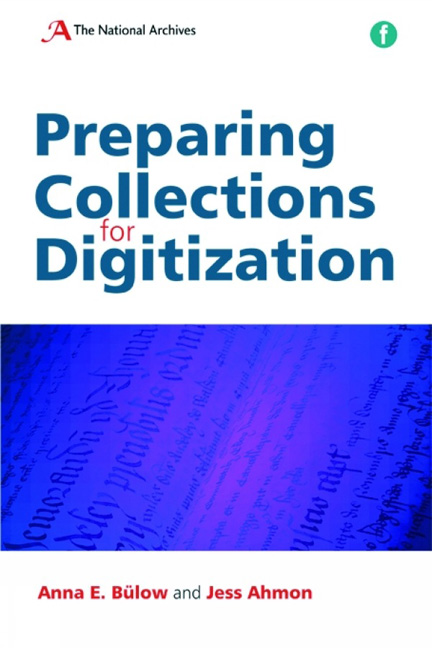Book contents
- Frontmatter
- Contents
- Acknowledgements
- List of figures and tables
- Introduction
- 1 Digitization in the context of collection management
- 2 Before you digitize: resources, suppliers and surrogates
- 3 The digital image Ross Spencer
- 4 The process of selection
- 5 Surveying collections
- 6 Equipment for image capture
- 7 Preparation of document formats and fastenings
- 8 Preparation of damaged documents
- 9 Setting up the imaging operation
- Conclusion
- Further reading
- Index
- Frontmatter
- Contents
- Acknowledgements
- List of figures and tables
- Introduction
- 1 Digitization in the context of collection management
- 2 Before you digitize: resources, suppliers and surrogates
- 3 The digital image Ross Spencer
- 4 The process of selection
- 5 Surveying collections
- 6 Equipment for image capture
- 7 Preparation of document formats and fastenings
- 8 Preparation of damaged documents
- 9 Setting up the imaging operation
- Conclusion
- Further reading
- Index
Summary
Digitizing collections means much more than taking images. Common perceptions of digitization projects requiring a scanner, a scanning operator and an item to be scanned, do not do justice to the often highly complex process of planning and preparing for digitization, image capture, quality control and metadata creation, eventually leading to successful online delivery of content. For an institution to own a set of digital images does not automatically mean that its collections are any more accessible than they were prior to digitization.
Digitization may have two functions within the context of managing collections: digital surrogates may serve as access copies instead of the originals, therefore aiding its preservation through less handling requirements; or they may be used to reach new audiences through online delivery. In both cases, the aims can only be fulfilled if image quality is optimal for the intended purpose, taking into account current and future audiences, and planning for the future preservation of both the original collections as well as the digital surrogate. Making information accessible through online channels also requires appropriate finding systems, such as a catalogue, to be in place, as well as a retrieval system in order to deliver content to the user.
The collection manager, with their eye for detail as well as their knowledge of materials and formats, will have a lot to contribute to the successful implementation of digitization projects. Supporting the digitization of collections does not just mean facilitating the image capture process by providing the documents; it is not a matter of following the same well known protocols time and again for every project. Rather, it is about gathering knowledge about individual collections and their users, and using this knowledge to inform all practical aspects of such ventures, including resource requirements, workflow and equipment. Their involvement will ensure that image quality is as good as it can get; but they will also enable cost-effective running of such projects by making sure that potential problems during scanning have been dealt with before they arise.
Digitization undoubtedly has an impact on an institution's conservation studio, and conservators will need to adapt their work in the digitization context. However, the conservator's skill set is entirely compatible with the digitization of heritage collections. Where digitization aims to preserve and use the collection, a conservator is well placed to make judgements on balancing preservation and use.
- Type
- Chapter
- Information
- Preparing Collections for Digitization , pp. 171 - 172Publisher: FacetPrint publication year: 2010



